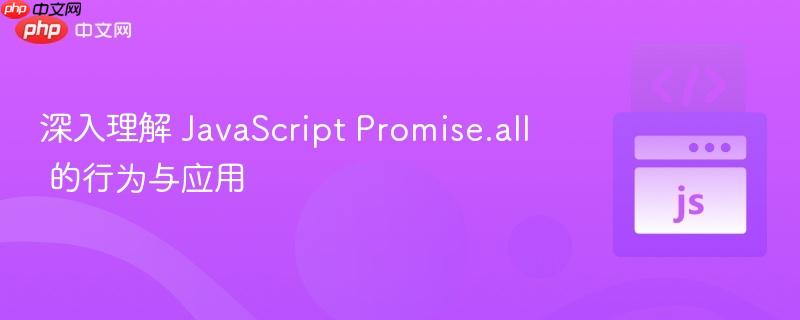
promise.all 是 javascript promise 对象的一个静态方法,旨在帮助开发者并行处理多个异步操作,并在所有操作都成功完成后聚合它们的结果。它接收一个可迭代的 promise 对象(通常是一个 promise 数组)作为输入,并返回一个新的单一 promise。
根据 MDN 文档的定义,Promise.all() 返回的 Promise 具备以下特性:
为了更好地理解 Promise.all 的行为,我们首先定义一个简单的异步工具函数 timeOut,它返回一个在指定时间后解决的 Promise:
const timeOut = (t) => {
return new Promise((resolve, reject) => {
setTimeout(() => {
resolve(`Completed in ${t}`);
}, t);
});
};考虑以下代码片段,它展示了 Promise.all 和独立 Promise 链的混合使用:
// 独立的 Promise 链 timeOut(1000) .then(result => console.log(result)); // 输出: Completed in 1000 (大约在 1000ms 后) // 使用 Promise.all Promise.all([timeOut(1000), timeOut(2000), timeOut(2000)]) .then(result => console.log(result)); // 输出: ['Completed in 1000', 'Completed in 2000', 'Completed in 2000'] (大约在 2000ms 后)
许多开发者可能会预期输出是按顺序打印每个 timeOut 的完成信息,然后是 Promise.all 的结果数组,例如:
立即学习“Java免费学习笔记(深入)”;
Completed in 1000 Completed in 2000 Completed in 2000 ['Completed in 1000', 'Completed in 2000', 'Completed in 2000']
然而,实际的输出通常是:

websenB2B是一套经过完善设计的B2B行业网站程序,是windows nt系列环境下最佳的B2B行业网产站解决方案。精心设计的架构与功能机制,适合从个人到企业各方面应用的要求,为您提供一个安全、稳定、高效、易用而快捷的行业网站商务系统。分普及版和商业版等不同版本。一、网胜B2B电子商务系统SP6.2蓝色风格普及版本升级功能说明:1、邮件群发功能:可以选择某一级别的会员,并放入支持html
 0
0

Completed in 1000 ['Completed in 1000', 'Completed in 2000', 'Completed in 2000']
这种差异是由于对 Promise.all 行为的误解造成的。关键在于 console.log 的位置以及 Promise 链的独立性:
独立 Promise 链的行为: timeOut(1000).then(result => console.log(result)) 是一个独立的 Promise 链。它会在大约 1000 毫秒后解决,并立即执行其 .then() 回调,打印出 Completed in 1000。
Promise.all 的聚合行为: Promise.all([timeOut(1000), timeOut(2000), timeOut(2000)]) 会并行启动内部的三个 timeOut Promise。
因此,Completed in 1000 的输出会在 1000 毫秒时出现,而 Promise.all 的结果数组则会在 2000 毫秒时出现。这就是为什么 Completed in 2000 没有单独打印,因为 Promise.all 自身只提供一个最终的聚合结果,它不会在内部 Promise 解决时单独触发 console.log。
如果你需要监控每个 Promise 的中间状态或单独处理它们的解决,你需要为每个 Promise 单独附加 .then()。如果你只需要所有 Promise 完成后的聚合结果,Promise.all 则是最简洁高效的选择。
以下示例展示了如何清晰地区分这两种情况:
const timeOut = (t) => {
return new Promise((resolve, reject) => {
setTimeout(() => {
// 内部日志可以帮助理解 Promise 何时解决
console.log(`[Internal] Promise for ${t}ms resolved.`);
resolve(`Completed in ${t}`);
}, t);
});
};
console.log("--- 独立 Promise 处理 ---");
// 独立处理每个 Promise,它们会按照各自的解决时间打印
timeOut(1000).then(result => console.log(`[Individual] ${result}`));
timeOut(2000).then(result => console.log(`[Individual] ${result}`));
timeOut(500).then(result => console.log(`[Individual] ${result}`));
console.log("--- Promise.all 聚合处理 ---");
// Promise.all 会等待所有 Promise 完成后,一次性打印聚合结果
Promise.all([timeOut(1000), timeOut(2000), timeOut(3000)])
.then(results => console.log(`[Promise.all] All results: ${results}`))
.catch(error => console.error(`[Promise.all] Rejected: ${error}`));
/*
预期输出顺序可能类似 (时间顺序):
[Internal] Promise for 500ms resolved.
[Individual] Completed in 500
[Internal] Promise for 1000ms resolved.
[Individual] Completed in 1000
[Internal] Promise for 1000ms resolved. (来自 Promise.all 内部的 1000ms Promise)
[Internal] Promise for 2000ms resolved.
[Individual] Completed in 2000
[Internal] Promise for 2000ms resolved. (来自 Promise.all 内部的 2000ms Promise)
[Internal] Promise for 3000ms resolved. (来自 Promise.all 内部的 3000ms Promise)
[Promise.all] All results: Completed in 1000,Completed in 2000,Completed in 3000
*/Promise.all 是处理多个并发异步操作的强大工具,它允许我们等待所有操作完成后,一次性获取它们的聚合结果。理解其核心行为,特别是它如何等待所有 Promise 解决以及如何聚合结果,对于避免常见的异步编程陷阱至关重要。通过合理地使用 Promise.all,我们可以编写出更高效、更健壮的异步 JavaScript 代码。
以上就是深入理解 JavaScript Promise.all 的行为与应用的详细内容,更多请关注php中文网其它相关文章!

每个人都需要一台速度更快、更稳定的 PC。随着时间的推移,垃圾文件、旧注册表数据和不必要的后台进程会占用资源并降低性能。幸运的是,许多工具可以让 Windows 保持平稳运行。

Copyright 2014-2025 https://www.php.cn/ All Rights Reserved | php.cn | 湘ICP备2023035733号